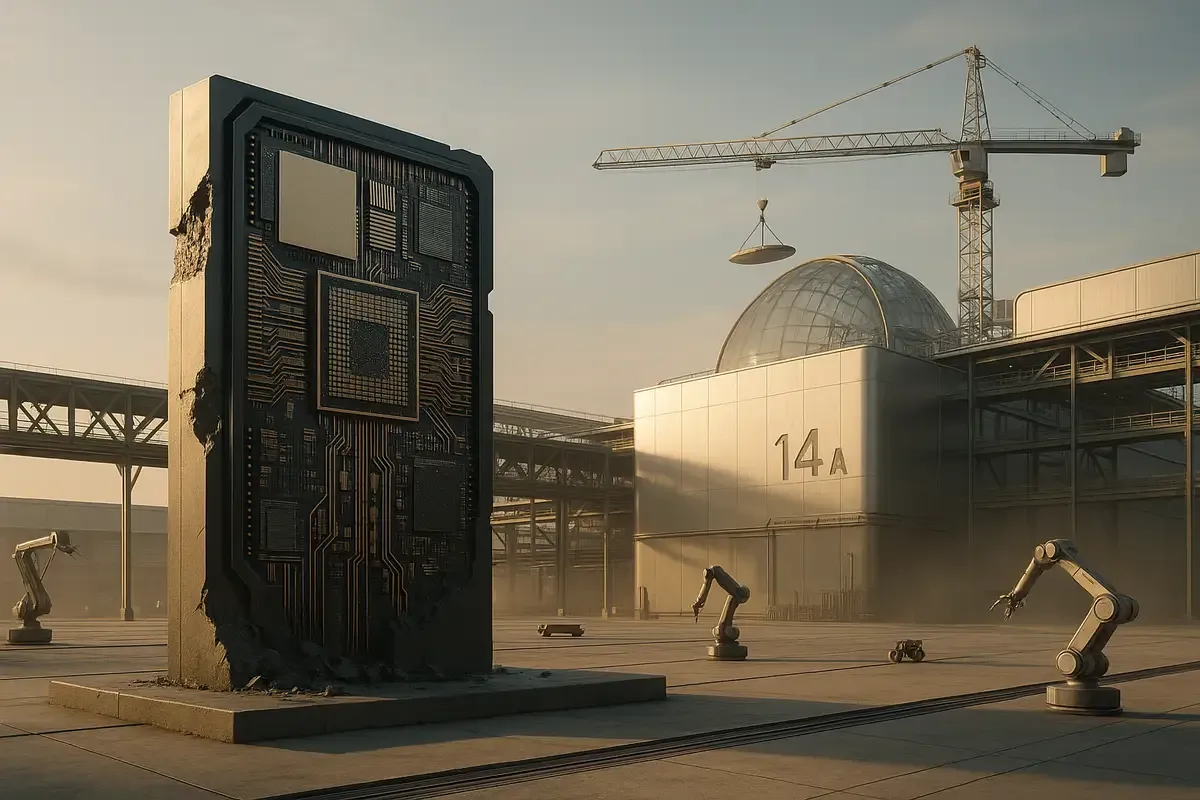AI News
Intel CEO Eyes Strategic Overhaul in Costly Bid to Regain Tech Edge
Intel's new CEO wants to abandon a multibillion-dollar chip technology his predecessor championed. The risky pivot to next-gen 14A aims to win back Apple and Nvidia from TSMC—but could cost billions in write-offs. Stakes couldn't be higher.
💡 TL;DR - The 30 Seconds Version
👉 Intel CEO Lip-Bu Tan wants to stop selling 18A chips externally and bet everything on next-gen 14A technology instead
💸 The shift could trigger write-offs worth hundreds of millions to billions—adding to Intel's record $18.8 billion loss in 2024
📊 Intel's 18A process matches TSMC's N3 tech from late 2022, while TSMC's newer N2 stays on schedule
🎯 Tan's strategy targets Apple and Nvidia as customers—both currently pay TSMC to make their most advanced chips
⏰ Intel's board discusses options this month, but the complexity and stakes mean final decision might wait until autumn
🚀 Success with 14A could restore Intel's manufacturing edge; failure might cement its permanent second-place status behind TSMC
Intel's new CEO wants to throw out his predecessor's playbook. Three months into the job, Lip-Bu Tan is already eyeing a multibillion-dollar strategic shift that would abandon years of work on a key manufacturing technology.
The plan? Stop selling Intel's 18A chipmaking process to outside customers and bet everything on the next generation instead. It's a move that could cost Intel hundreds of millions—if not billions—in write-offs. But Tan thinks it might be the only way to catch rival TSMC and win back customers like Apple and Nvidia.
Intel's board will weigh the options as early as this month, according to sources familiar with the matter. The decision won't be easy. The 18A process has already consumed billions in development costs under former CEO Pat Gelsinger, who left the company in March.
The 18A Problem
Here's the uncomfortable truth facing Intel: While it spent years developing 18A technology, TSMC kept moving ahead. Industry analysts say Intel's 18A is roughly equivalent to TSMC's N3 process—which went into production back in late 2022.
That's not exactly a winning pitch to prospective customers.
Tan started voicing concerns about 18A by June. The technology just wasn't attracting the external customers Intel desperately needs. Meanwhile, TSMC's newer N2 technology stays on track for production.
Intel will still use 18A for its own chips. The company's "Panther Lake" laptop processors are designed for 18A and set to begin production later this year. Intel also has commitments to make chips for Amazon and Microsoft using the process. Those deals are too far along to change.
But for new customers? Tan wants to skip straight to 14A.
Why 14A Might Work
The 14A process represents Intel's next shot at matching—or beating—TSMC. It's where Tan believes Intel can finally gain an edge.
The strategy makes sense on paper. Why chase customers with yesterday's technology when you could offer tomorrow's? The problem is timing. Intel needs to deliver 14A on schedule and convince major players to wait for it.
Tan brings decades of chip industry connections to this challenge. He's been working those relationships to understand what customers actually want. The message seems clear: 18A isn't it.
Intel declined to comment on "hypothetical scenarios." The company says it remains committed to strengthening its roadmap and building customer trust. Standard corporate speak for "we're not confirming anything."
The Cost of Change
Abandoning external 18A sales won't come cheap. Intel would need to write off much of its investment in developing the technology for outside customers. Industry analysts suggest the charge could reach into the billions.
This comes at a tough time for Intel. Last year marked the company's first unprofitable year since 1986, with a net loss of $18.8 billion. The chipmaker has fallen behind in mobile computing and artificial intelligence—two waves that defined the past two decades of tech.
Tan inherited these problems when he took over in March. His response has been swift. He's brought in new engineering talent and worked to shrink what he saw as bloated middle management. Now he's targeting the foundry strategy itself.
The board faces a complex decision. Sources suggest they might not reach a final verdict until autumn, given the stakes involved. Intel could still decide to stick with its existing 18A plans. But Tan's push for change signals how seriously he takes Intel's competitive crisis.
The TSMC Challenge
Intel's foundry ambitions matter because they represent the company's path back to relevance. Persuading outside clients to use Intel's factories—rather than TSMC's—is crucial for the company's future.
TSMC currently manufactures chips for most of the industry's biggest names. Apple relies on the Taiwanese company for its iPhone processors. Nvidia uses TSMC for its AI chips. Breaking that dominance requires more than matching TSMC's technology—Intel needs to exceed it.
The 18A process was supposed to do just that. It includes novel features like a new method of delivering power to chips and an advanced transistor design. On paper, these improvements should help Intel catch up.
Reality has proven different. Delays hit the 18A process while TSMC kept executing. Now Tan believes the better bet is focusing resources on 14A, where Intel might have a real advantage.
What Happens Next
If Intel's board approves Tan's strategy, the company would redirect its foundry employees, design partners, and customer outreach toward 14A. It's a high-stakes bet on being able to deliver next-generation technology on time.
The irony is thick. Intel once dominated chip manufacturing so thoroughly that "Intel Inside" became a household phrase. Now it's fighting to convince anyone outside to use its factories at all.
Tan's willingness to consider such an expensive strategy shift just months into the job shows the urgency of Intel's situation. The company can't afford to chase TSMC with outdated technology. But it also can't afford many more multibillion-dollar write-offs.
Why this matters:
- Intel's foundry strategy could determine whether America maintains any serious chip manufacturing capability as AI drives unprecedented demand for advanced processors
- If Tan succeeds in landing Apple or Nvidia as customers, it would crack TSMC's monopoly and prove Intel can still compete at the highest level—failure might relegate Intel to permanent also-ran status
❓ Frequently Asked Questions
Q: What do 18A and 14A actually mean?
A: These numbers represent chip manufacturing process nodes measured in angstroms. Smaller numbers mean more advanced technology. 18A equals 1.8 nanometers, while 14A equals 1.4 nanometers. Each generation packs more transistors into less space, improving performance and efficiency.
Q: Who is Lip-Bu Tan and what's his background?
A: Tan took over as Intel CEO in March 2025 from Pat Gelsinger. He has decades of chip industry experience and extensive customer relationships. Since starting, he's brought in new engineering talent and worked to reduce middle management layers he saw as bloated.
Q: What happens to Amazon and Microsoft's chip orders?
A: Intel will still produce their guaranteed chips using 18A technology. These contracts have deadlines that make switching to 14A unrealistic. The company says it will deliver on all existing customer commitments, though volumes are described as "relatively small."
Q: When would 14A technology be ready for customers?
A: The article doesn't specify exact timelines for 14A. Intel aims to start high-volume 18A production later in 2025. Industry sources suggest delivering 14A in time to win major contracts "is by no means certain," indicating significant development time remains.
Q: How much has Intel already invested in 18A development?
A: Intel spent "billions of dollars" developing 18A and its variant 18A-P. Industry analysts estimate potential write-offs could range from hundreds of millions to billions. This adds to Intel's $18.8 billion net loss in 2024, its first unprofitable year since 1986.
Q: What makes Panther Lake processors important to Intel?
A: Panther Lake laptop chips represent Intel's own use of 18A technology, with production starting later in 2025. Intel calls them "the most advanced processors ever designed and manufactured in the United States." They'll demonstrate whether 18A works well for Intel's internal needs.
Q: Could Intel still decide to keep selling 18A to external customers?
A: Yes. Sources say Intel could choose to stick with existing 18A plans. The board will discuss options this month but might not decide until autumn due to complexity and financial stakes. Nothing is final until the board votes.








